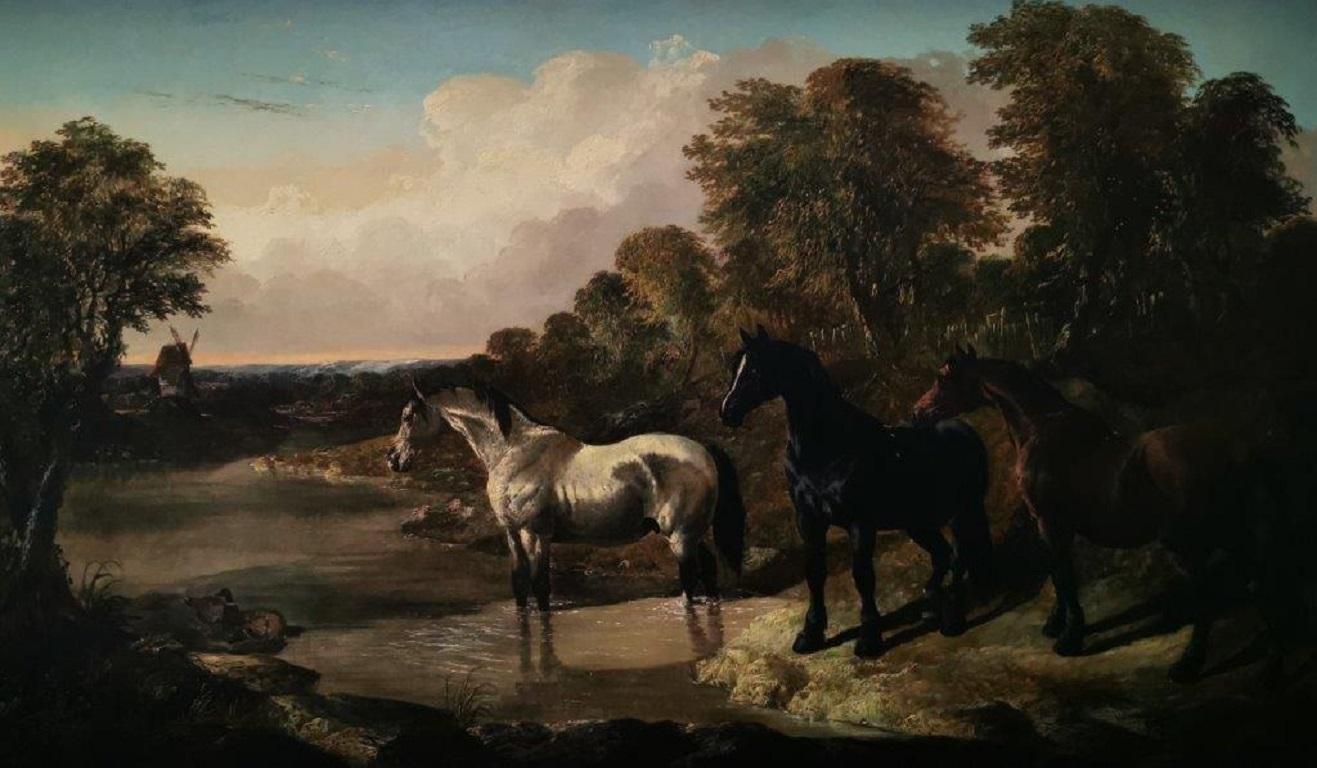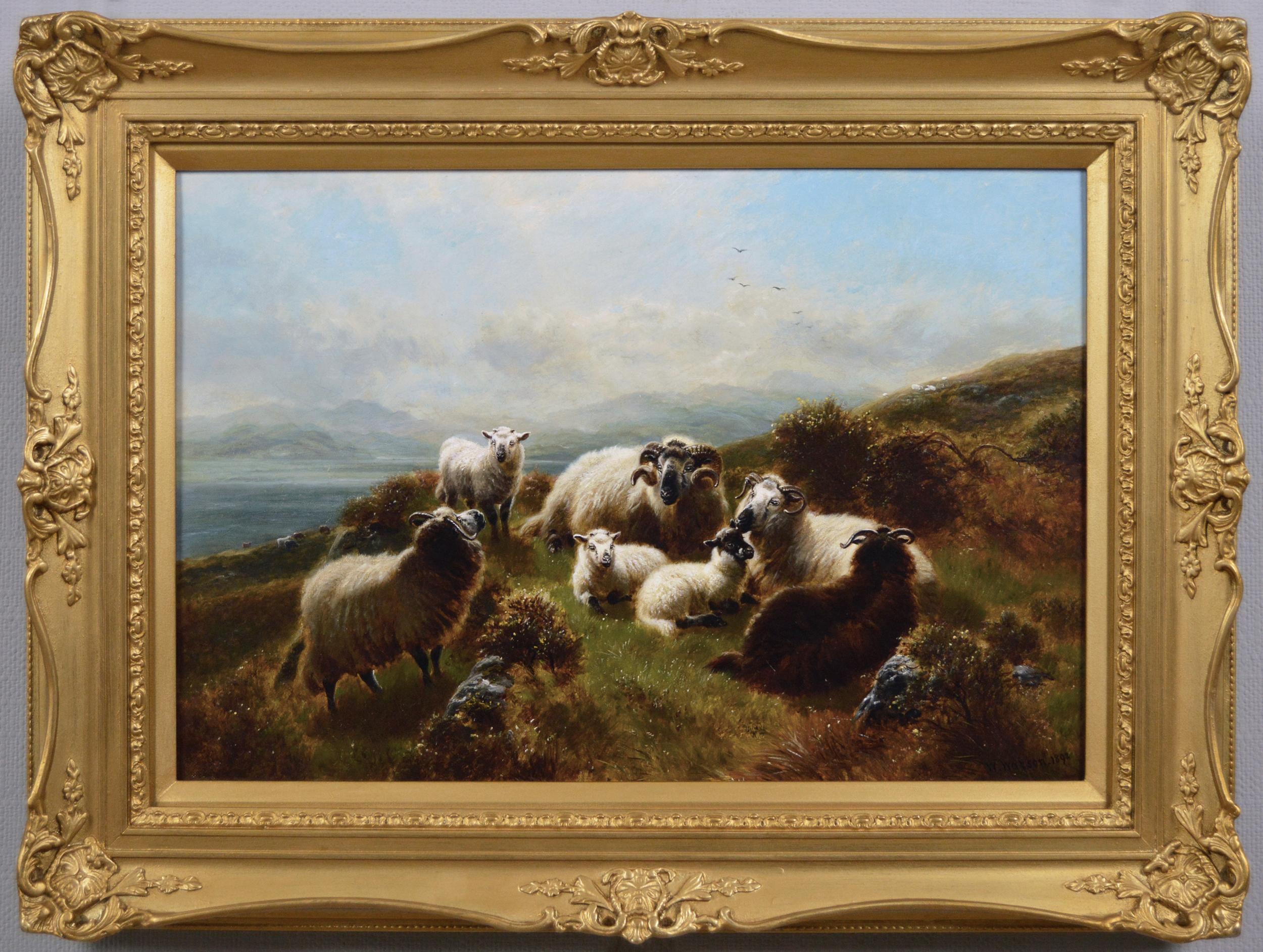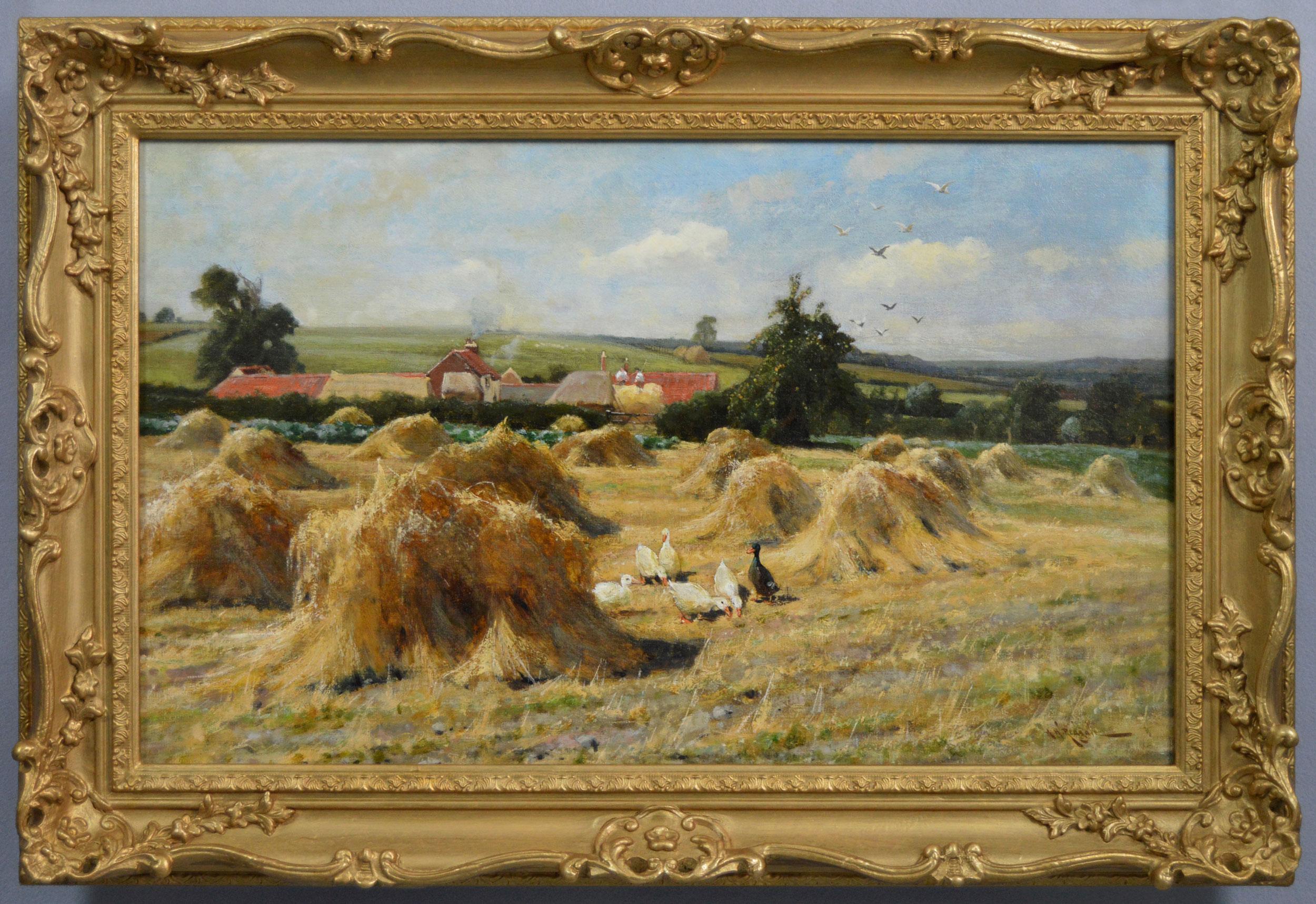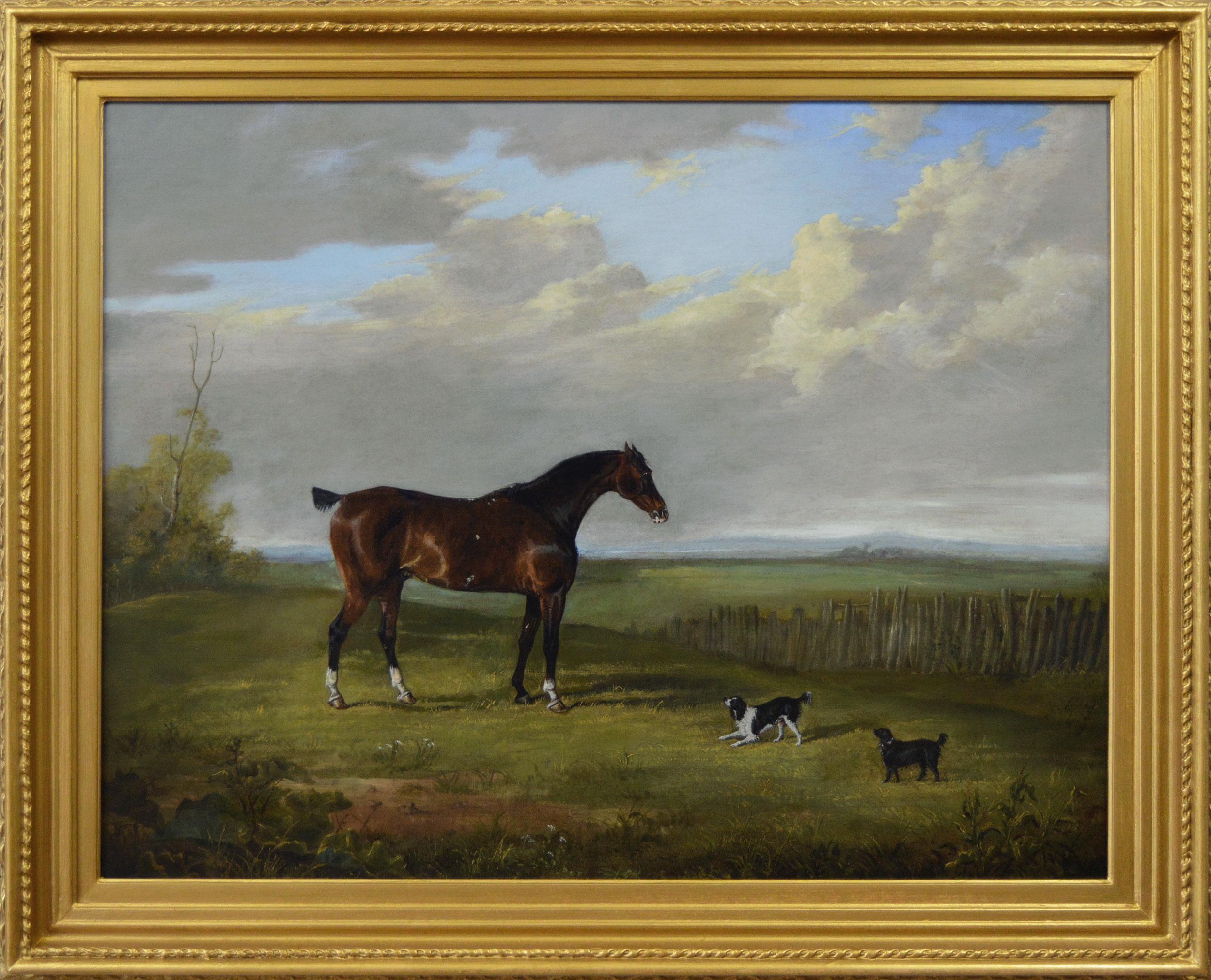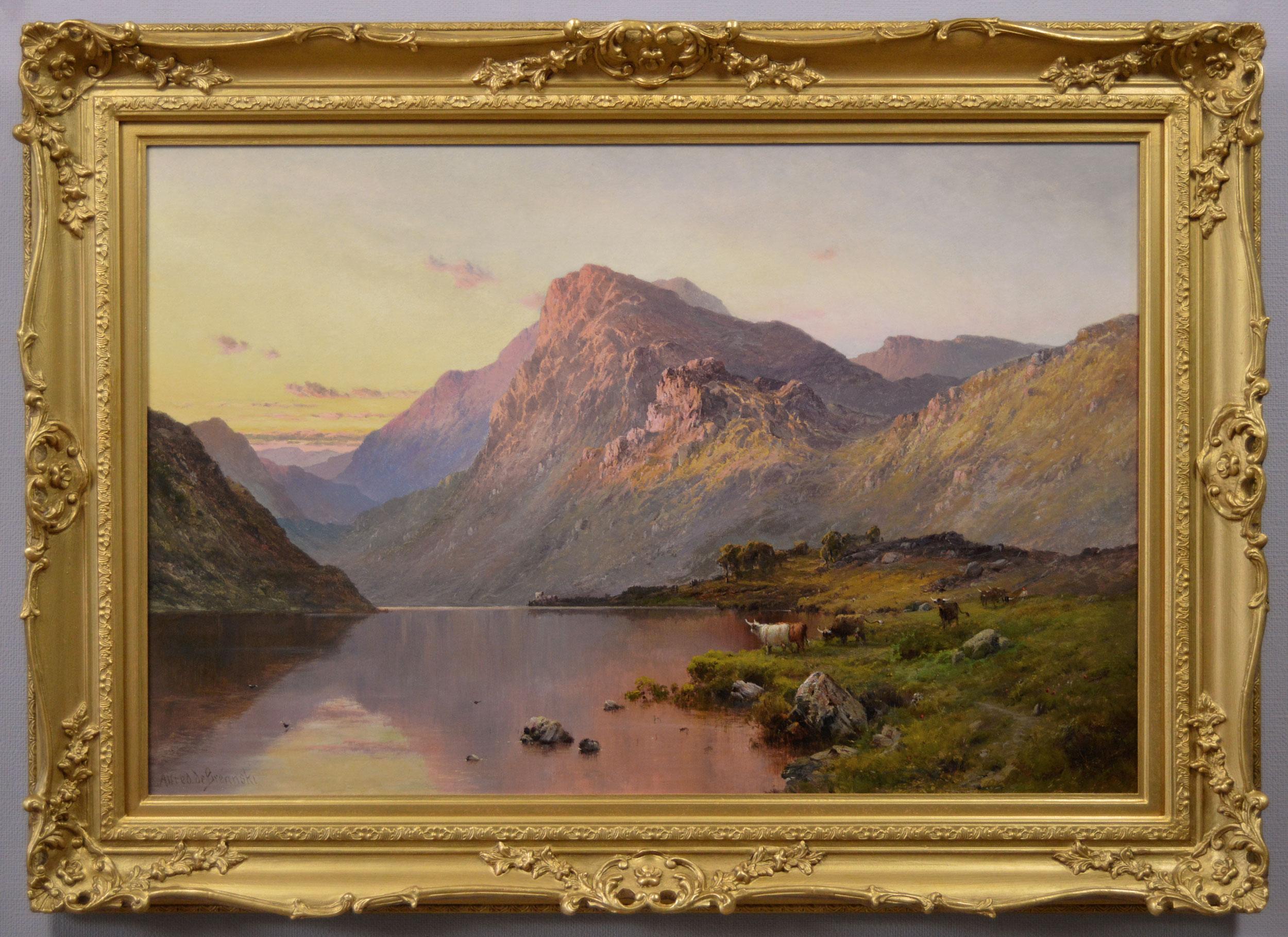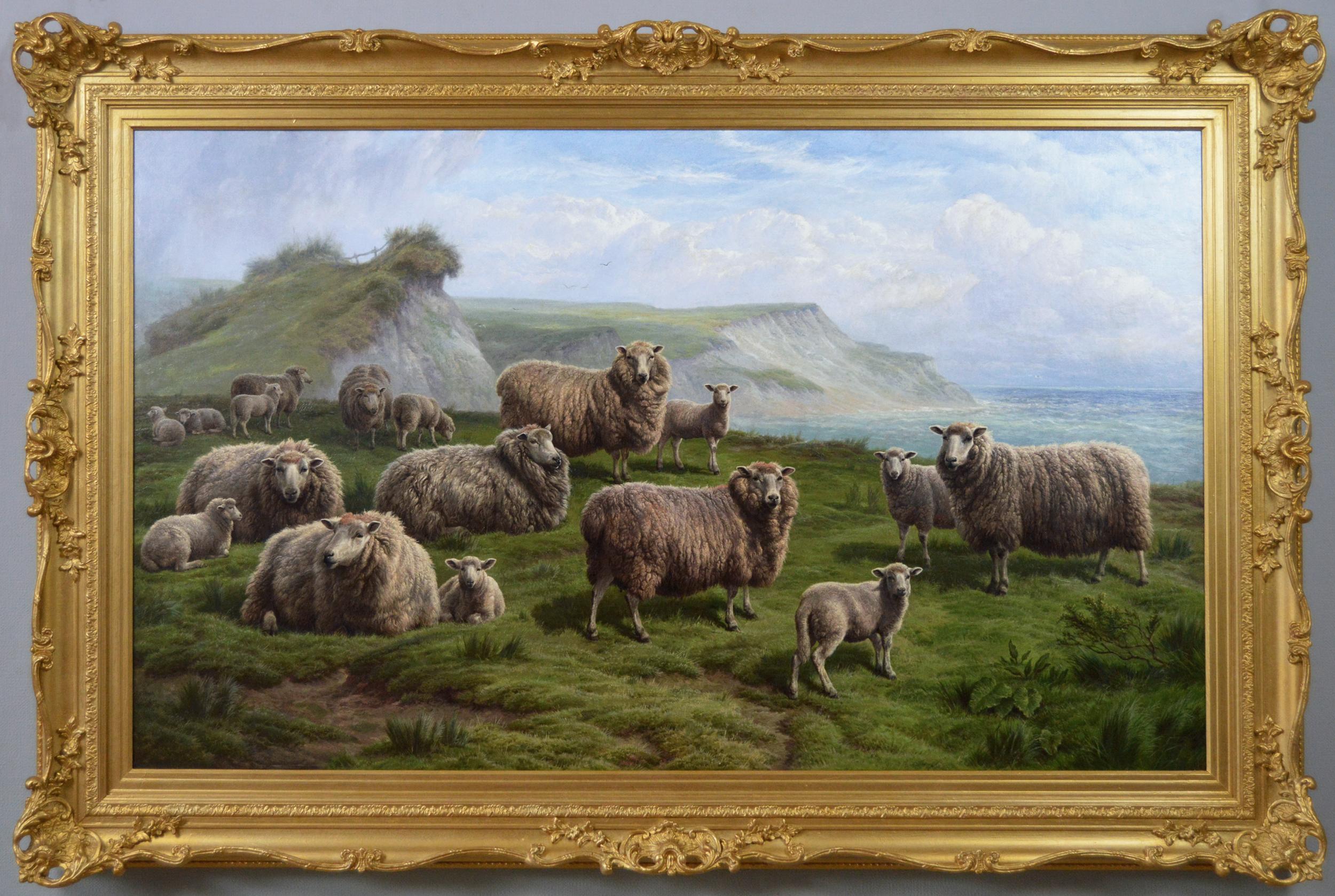Items Similar to Antique English 19th century Horse, Hunter with terrier in a landscape.
Want more images or videos?
Request additional images or videos from the seller
1 of 13
James BarengerAntique English 19th century Horse, Hunter with terrier in a landscape. Circa 1830
Circa 1830
About the Item
Barenger was born in Kentish Town, London, the son of James Barenger Snr., a metal chaser and artist who exhibited paintings of insects at the Society of Artists and Royal Academy, and Sarah Woollett, the daughter of the engraver, William Woollett. His brother Samuel Barenger (christened Major Samuel Barenger) also became an engraver. Beginning as a landscape artist, Barenger went on to specialise in painting horses, dogs and other animals, and hunting scenes. In 1807, at the age of 28, he exhibited at the Royal Academy for the first time. At this stage, he was living with his father in Kentish Town, but later moved to Camden Town. He went on to exhibit 48 paintings at the Royal Academy and eight at the British Institution. He acquired numerous wealthy and aristocratic patrons, and his pictures were also engraved for sporting publications such as W. H. Scott's British Field Sports, The Sporting Repository, The Annals of Sporting and The Sporting Magazine. For the last of these, Scott engraved Barenger's painting of the racehorse Blucher (ca. 1814). As well as painting, Barenger also bred pointer dogs. He died on 1 October 1831 and was buried in Old St Pancras churchyard.
This painting is a very good example of classic British Sporting art and would look amazing in any interior.
- Creator:James Barenger (1780 - 1831)
- Creation Year:Circa 1830
- Dimensions:Height: 32 in (81.28 cm)Width: 37 in (93.98 cm)
- Medium:
- Movement & Style:
- Period:
- Condition:The painting is in original condition, having been cleaned and revarnished about 10 years ago.
- Gallery Location:Woodbury, CT
- Reference Number:1stDibs: LU507313935572
About the Seller
5.0
Platinum Seller
These expertly vetted sellers are 1stDibs' most experienced sellers and are rated highest by our customers.
Established in 1983
1stDibs seller since 2016
410 sales on 1stDibs
Typical response time: <1 hour
- ShippingRetrieving quote...Ships From: Reigate, United Kingdom
- Return PolicyA return for this item may be initiated within 7 days of delivery.
More From This SellerView All
- English 19th century forest landscape with horses in the New Forest Hampshire UKBy William BradleyLocated in Woodbury, CTEnglish landscape painter from the 1870's who exhibited at the Royal Academy and the British Institute in London. He mostly painted in watercolors and this example would have been p...Category
1860s Victorian Landscape Paintings
MaterialsOil, Canvas
- 19th century English fox hunter on his horse oil in a landscapeBy William Joseph ShayerLocated in Woodbury, CTWilliam Joseph Shayer English sporting painter from the 19th century. He painted mostly on a small scale with great detail and quality. The son of William Shayer senior he must ha...Category
1870s Victorian Animal Paintings
MaterialsCanvas, Oil
- 19th century English Harvest landscape with horses, farmers, children, familyLocated in Woodbury, CTHenry Brittian Willis English plough team at rest during harvest Summertime. A painting by Henry Brittiam Willis capturing a 19th-century English plough team, complete with horses,...Category
1850s Victorian Landscape Paintings
MaterialsCanvas, Oil
- Antique 19th century English, pair of Huntsman riding with hounds in a landscapeBy John Frederick Herring JrLocated in Woodbury, CTJohn Frederick Herring Junior, Antique 19th century English, pair of Huntsman riding with hounds in a landscape. John Frederick Herring Jnr. was a painter of sporting and animal s...Category
1860s Victorian Animal Paintings
MaterialsOil, Wood Panel, Canvas
- Antique 19th century English, Cart Horses in a farmyard landscape with cottage.By John Frederick Herring JrLocated in Woodbury, CTJohn Frederick Herring Junior, Antique 19th century English, Cart Horses in a farmyard landscape with cottage. John Frederick Herring Jnr. was a painter of sporting and animal subjects in oil and watercolor. His style was very similar to that of his father, John Frederick Herring Snr...Category
1860s Victorian Animal Paintings
MaterialsCanvas, Oil
- 19th century Scottish Highland lock landscape with Highland Cattle drinkingLocated in Woodbury, CTLate 19th century Scottish Highland Lock landscape, with Cattle watering E.Mulready was almost certainly a pseudo name for William Langley a well known English painter of landscapes...Category
1890s Victorian Landscape Paintings
MaterialsOil, Canvas
You May Also Like
- "A River Landscape with Wild Horses", Victorian original, oil on canvasBy John Frederick Herring JrLocated in Nutfield, SurreyThis is an original unique oil painting by the artist. Born into an artistic family in Doncaster, England during 1820. Best known for his equine art, of the same character as those of the elder Herring, including "The Home Farm," "The Homestead," "The Farm-Yard," etc.John F. Herring, Jr. was born in Doncaster, South Yorkshire c.1820, to the well-known 19th-century artist John Frederick Herring, Sr. (1795-1865), who at the time, was considered one of England's great Sporting and Equestrian artists, patronized by the English aristocracy. The father's mastery of the brush, and popularity with the nobility, served his son, Herring, Jr., well. Early on, John, Jr. was exposed to fine painting and wealthy patrons. Recent reference books state that Herring, Sr.'s first child was named "John Frederick Herring, Jr." and was born on June 21, 1815. John Herring, Jr. developed a love for painting, a passion also shared by his brothers Charles and Benjamin. Three of the four brothers became artists, painting in the same style as their father, often collaborating on a single painting. In the years after 1836, Herring, Sr., feeling threatened by the teenage John Herring, Jr.'s ability and growing popularity, began incorporating the tag "SR" at the end of his signature. John Herring, Jr. continued painting in the tradition of his father, the sporting and animal pictures...Category
19th Century Victorian Landscape Paintings
MaterialsCanvas, Oil
- 19th Century Highland landscape oil painting of sheep near Loch AweLocated in Nr Broadway, WorcestershireWilliam Watson Jnr British, (1847-1921) On the Mountains, Loch Awe Oil on canvas, signed & dated 1892, further inscribed verso Image size: 12.5 inches x 18.5 inches Size including frame: 18.5 inches x 24.5 inches A wonderful painting of Highland sheep resting near Loch Awe by William Watson Jnr. Loch Awe is located in Argyll and Bute in the Scottish Highlands and this scene is taken from the mountain side overlooking the loch. William Watson was born in Islington in 1847, the son of the London miniature painter William John Watson (1810-1871) and his wife Caroline (née Butcher). His brothers Charles Watson (1837-1900) and Robert Watson (1855-1921) were also artists. His father seems to have travelled around and after spending time in Brighton, the family moved to Bransford Road in Worcester during the early part of the 1860’s. As well as being taught by his father, Watson received his early training in the studio of Sir Francis Grant PRA (1803-1878). He later became a pupil of Sir Edwin Henry Landseer RA (1802-1873) and Rosa Bonheur (1822–1899). Both Landseer and Bonheur had a great influence on his work and he began specialising in scenes of cattle and sheep. By 1866 he had become a full time artist and began exhibiting at the Royal Society of British Artists. Perhaps to take advantage of the inspiring scenery, Watson moved to Birkenhead, Cheshire where in 1871 he met and married Eleanor Davies who was from Caernarvonshire. Four of their children Sidney Watson (1881-1931), Caroline Ellen...Category
19th Century Victorian Animal Paintings
MaterialsCanvas, Oil
- 19th Century landscape oil painting of geese in a Nottinghamshire cornfieldLocated in Nr Broadway, WorcestershireArthur Walker Redgate British, (1860-1906) Wilford Hill Oil on canvas, signed, further inscribed verso Image size: 15.25 inches x 25.25 inches Size including frame: 21.25 inches x 3...Category
19th Century Victorian Landscape Paintings
MaterialsCanvas, Oil
- 19th Century sporting horse portrait oil painting of a racehorse with spanielsBy George Henry LaporteLocated in Nr Broadway, WorcestershireGeorge Henry Laporte British, (1802-1873) Best of Friends Oil on canvas, signed & indistinctly dated Image size: 27.25 inches x 35.25 inches Size...Category
19th Century Victorian Animal Paintings
MaterialsCanvas, Oil
- 19th Century Scottish Highland landscape oil painting of Loch LubnaigBy Alfred de Breanski Sr.Located in Nr Broadway, WorcestershireAlfred de Breanski Snr British, (1852-1928) The Head of Loch Lubnaig Oil on canvas, signed & transcribed verso Image size: 23.5 inches x 35.5 inches Size...Category
19th Century Victorian Landscape Paintings
MaterialsCanvas, Oil
- 19th Century exhibition size landscape oil painting of Sheep on a cliffBy Charles Jones (b.1836)Located in Nr Broadway, WorcestershireCharles Jones British, (1836-1892) Sheep Resting Oil on canvas, signed with monogram & dated 1877, further inscribed verso Image size: 35 inches x 59 inches Size including frame: 47 inches x 71 inches Exhibition Size Painting A fantastic exhibition sized landscape painting of sheep on a cliff top by the coast by Charles ‘Sheep’ Jones. At the time he produced this painting, Jones was living at Heathercroft, Balham Hill in London. Given the size and quality of the work it was most likely an exhibition piece. The topography and landscape suggest that this is the Dorset coast, one of his favourite places to paint. Charles Jones was an animal painter who was born in Stepney, London in 1836. He was the son of the artist Samuel John Egbert Jones (1797-1861) and Dinah Jones. He lived with his parents and 9 siblings in Mile End and was a pupil of his father. In September 1859, he married Frances Rosalinda Downe, who was born in America. His son Arthur Bertram Loud (1863-1930) also became an artist. They lived at 12 Hayes Place, Lisson Grove from where he made his debut in London at the Royal Academy in 1861. He also exhibited at the British Institution, Suffolk Street, New Watercolour Society, Royal Institute of Oil Painters and the Royal Institute of Painters in Watercolours. By 1867, he had become a successful artist and they had moved to 7 Paragon Place, Brixton Hill. From 1874 he lived at Heathercroft, Balham Hill where he spent the rest of his life. Jones became well known for specialising in paintings of sheep, cattle and deer in landscape settings. He spent his time travelling around visiting areas such as Devon, Dorset, Kent, Sussex and the Highlands. However, it is for his skilful painting of sheep that he is perhaps best known, and for which earned him the nickname of ‘Sheep’ Jones. As well as the major London galleries, he also exhibited provincially at various locations including: the Royal Cambrian Academy where he was elected a member in 1886, the Glasgow Institute of Fine Arts, Manchester City Art Gallery, Royal Hibernian Academy, Royal Society of British Artists, Birmingham and the Walker Art Gallery, Liverpool. Some of the smaller more intimate galleries he exhibited at were Arthur Tooth & Sons and Thomas...Category
19th Century Victorian Animal Paintings
MaterialsCanvas, Oil
Recently Viewed
View AllMore Ways To Browse
19th Century Horse
Hunter Century
English Living Paintings
James Field
Paintings Of Insects
Paintings St James
19th Century Painting Horse
Dior Patron
Antique Metal Animals
London St James
19th Century Horse Oil
English Horse Painting
Scotts Antique
English Painting Of Horse
Classic English Paintings
Art And Antique Hunter
19th Century Oil Painting Of A Horse
48 Horse
